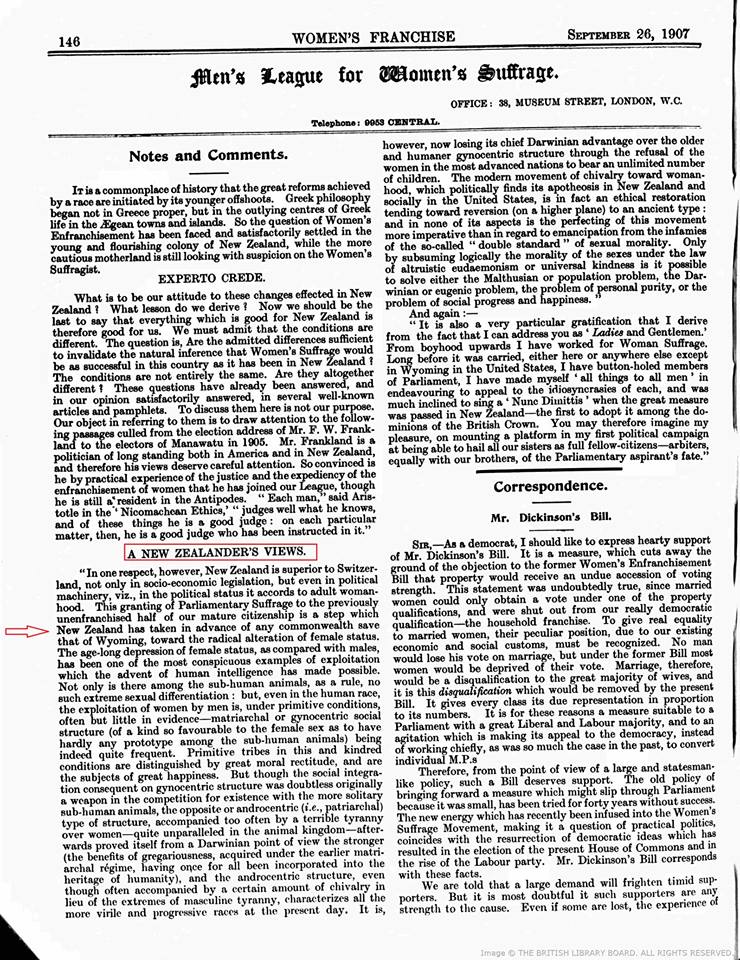Source: Hackney and Kingsland Gazette – Wednesday 12 July 1871


Source: Hackney and Kingsland Gazette – Wednesday 12 July 1871



The following article mentions a popular theory of gynocentrism (created by Lester Ward) circulating at the start of the twentieth century. Feminists of the time believed, and still believe, that gynocentrism should serve as the dominant social order.- PW.

Daniel Naurin, Elin Naurin, Amy Alexander (2019)

ABSTRACT:
Gender stereotypes—stylized expectations of individuals’ traits and capabilities based on their gender—may affect the behavior of diplomats and the processes of international negotiations. In a survey experiment in the Council of the European Union, we find that female representatives behaving stereotypically weak and vulnerable may trigger a chivalry reaction among male representatives, increasing the likelihood that the men will agree to support a bargaining proposal from the women.
The effect is conditional on the negotiators’ cultural background—the chivalry reaction is displayed mainly by diplomats from countries with relatively low levels of gender equality. Our study contributes to the research on nonstandard behavior in international relations, and in particular the expression and reception of emotions in diplomacy.
We argue that gender stereotypes may have a moderating impact on decision making based on such intuitive cognitive processes. We also add to the broader negotiation literature, both by showing the pervasiveness of gender stereotyping, and by testing at the elite level the generalizability of claims regarding gender effects derived from laboratory experiments. Overall, our findings demonstrate the importance of bringing gender into the study of international negotiations, where it has been largely and surprisingly ignored.
The following is an excerpt from Elizabeth Hobson’s latest article in PoliQuads Magazine.

Feminists Do Not Get To Define Feminism
By Elizabeth Hobson
Proto-feminism arose in the late Middle Ages. Queen consort of France and England, Eleanor of Acquitaine spearheaded a movement within her court to subvert the chivalric code (which had traditionally governed relations between knights and lords) to regulate the behaviour of men towards women. These women initiated a system of romantic feudalism wherein noble men were under irresistible pressure to identify a lady as midons (my lord) and to submit to her will and delicately accept any scorn that her midons saw fit to extend to him. Eleanor established “Courts of Love” in which she and her noble women would administer “justice” in romantic disputes. Not only may many men in particular recognise this state of gender relations, but the modus operandi that Eleanor and company used to achieve their supremacy is entirely familiar: generalizations about all men based on the poor behaviour of a minority, asserting that women need protection from men’s violations, and a narrative of women’s moral superiority justifying their dictatorship. Within 200 years, Eleanors’ ideas had spread and saturated throughout Europe and throughout the class system….. [continued]
*The rest of this article exploring the various waves of feminism can be read in PoliQuads Magazine
The following is from the introduction to my new co-authored book (with Paul Elam) of collected writings on chivalry. The book includes updated versions of previously published essays, and two excellent contributions by Paul Elam including a newly transcribed article Death By Chivalry: Portland Edition. You can purchase the eBook here, and the paperback here, or simply click on the cover picture below. – PW.
FROM THE INTRODUCTION
The importance of chivalry is taught to little girls and boys from the start, outlining for them the various rules of male obligation that will guide sexual relations throughout their lifetimes; i.e., males are here to protect and provide.
The victories of legendary cinematic heroes whose brave deeds are rounded with applause and happily-ever-afters appears to seal the fate of chivalry as the future path of every man.
Those few who do pause to question chivalry’s values however – its rote expectation of male sacrifice, possibility of danger or injury, impacts on mental health, potential for exploitation and abuse, or the question of valid compensations for ongoing sacrifices – may conclude that it serves as a poor life map, or worse that it amounts to a malignant and toxic form of masculinity.
This book examines the realities of chivalry beyond the usual platitudes and cliches to see what’s really at stake for men in the present zeitgeist. The essays, written by men’s advocates Peter Wright and Paul Elam, survey the roots of the chivalric tradition and examine real life examples of chivalry in action.
Chapters include:
1. The Birth Of Chivalric Love
2. A Bastardized Chivalry
3. What Ever Happened To Chivalry?
4. Sporting Tournaments: ‘It Will Make A Man Out Of You’
5. Intervening for women
6. Chivalry: A Learned Deathwish
7. Death By Chivalry: Portland Edition
8. Aggrieved Entitlement: Women’s Reaction to Temporary Loss Of Chivalry
9. Can A Woman Be Chivalrous?

Below is an excerpt from p.3 of the introduction to The Second Wave: A Reader In Feminist Theory, edited by Linda Nicholson. Note the promotion of differences between men and women, referred to as ‘difference feminism’ or ‘gynocentric feminism.’
__________________
In the late 1960s and early 1970s two contradictory beliefs existed as part of the general culture: that the differences between women and men were deep and rooted in nature and, secondly, that women and men were basically the same. Second wave feminists initially drew heavily on this latter belief to press for changes in the status quo. While many, particularly “liberal” feminists, continued in this direction, those feminists who saw their politics as more radical began to focus on the differences between women and men. This focus can in part be explained by the political limitations radical and socialist feminists saw as associated with a “women and men are the same” perspective.
Such a politics seemed to consist in pushing society towards accepting women in the same positions as men in an otherwise unaltered social world. But as one of the popular slogans of the period claimed: “Women who strive to be equal to men lack ambition.” For radical and socialist feminists, a politics that merely strove toward placing women where men had previously been also lacked ambition. If one were to build a politics which radically altered the status quo, one needed to focus on the deep ways society differentiated the life activities and psyches of women and men. What began to emerge can be described as a “difference” feminism; because it often elaborated the meaning of differences between women and men in terms of the unique situation and characteristics of women, it has also been labelled a “gynocentric” feminism.
This new focus on the differences between women and men was elaborated, however, in a variety of ways. In my selections I have identified three distinct orientations within this general turn. One way of moving away from a “women and men are fundamentally the same” perspective was to stress the depths of women’s oppression. A focus on oppression led toward a view of women as victims, and to the move toward separatism found in large sections of the radical feminist community during the 1970s. The essay “The Woman Identified Woman” and the chapter from MacKinnon reflect this first elaboration of difference.
A second type of gynocentrism tended toward describing the differences between women and men in more neutral terms, emphasizing both their positive and negative consequences on women’s lives. The Chodorow and Gilligan essays reflect this second type of orientation. A third type, represented here in the essays by Hartsock and Collins, focused on the ways in which the distinctive positions of women—for Hartsock, women in general and for Collins, African American women in particular—provide a unique and positive standpoint for understanding society and for developing a liberatory vision.
“Difference” or “gynocentric” feminism produced an enormous amount of highly creative work. The writings of such theorists as MacKinnon, Chodorow, and Gilligan led to “aha” experiences for large numbers of people. Suddenly, patterns that many had sensed “through a glass darkly” were laid out in clear and convincing texts.
___________________________
See also: Gynocentric Feminism – by Iris Young
Below is an excerpt from a 1985 paper entitled “Humanism, Gynocentrism, and Feminist Politics” by feminist Iris M. Young – PW.

Iris M. Young
Gynocentric feminism defines the oppression of women very differently from humanist feminism. Women’s oppression consists not of being prevented from participating in full humanity, but of the denial and devaluation of specifically feminine virtues and activities by an overly instrumentalized and authoritarian masculinist culture. Unlike humanist feminism, gynocentric feminism does not focus its analysis on the impediments to women’s self-development and the exclusion of women from the spheres of power, prestige, and creativity. Instead, gynocentric feminism focuses its critique on the values expressed in the dominant social spheres themselves.
The male-dominated activities with the greatest prestige in our society — politics, science, technology, warfare, business — threaten the survival of the planet and the human race. That our society affords these activities the highest value only indicates the deep perversity of patriarchal culture. Masculine values exalt death, violence, competition, selfishness, a repression of the body, sexuality, and affectivity.
Feminism finds in women’s bodies and traditionally feminine activity the source of positive values. Women’s reproductive processes keep us linked with nature and the promotion of life to a greater degree than men’s. Female eroticism is more fluid, diffuse, and loving than violence-prone male sexuality. Our feminine socialization and traditional roles as mothers give us the capacity to nurture and a sense of social cooperation that may be the only salvation of the planet.
Gynocentric feminism thus defines the oppression of women quite differently from the way humanistic feminism defines it. Femininity is not the problem, not the source of women’s oppression, but indeed within traditional femininity lie the values that we should promote for a better society. Women’s oppression consists of the devaluation and repression of women’s nature and female activity by the patriarchal culture.
? ? ?
Gynocentric feminism has received a number of expressions in the United States women’s movement in recent years. Artists and poets have been among the leaders in developing images of celebration of this more positive understanding of women’s history and contemporary self-understanding. Judy Chicago’s The Dinner Party, for example, laboriously and beautifully recovers whole aspects of women’s history and locates them within images of female genitalia and objects that rely on traditionally female arts.
Within the sphere of political activism, gynocentric feminism perhaps is best represented in the feminist antimilitarist and ecology movements of the past five years. In the Women’s Pentagon Action or the action at the Seneca Army Depot, for example, a major aspect of the political protest has been the use of symbols and actions that invoke traditional labor, such as weaving, spinning, birthing, mothering. Feminist antimilitarist and ecological analysis has argued that the dangers to the planet that have been produced by the nuclear arms race and industrial technology are essentially tied to masculinist values. The burgeoning movement of feminist spirituality entails a similar analysis and promotes values associated with traditional femininity.
A number of prominent recent theories of contemporary feminism express a gynocentric feminism. I see Susan Griffin’s Woman and Nature as one of the first written statements of gynocentric feminism in the second wave. It shows that one of the first steps of gynocentrism is to deny the nature/culture dichotomy held by humanists such as Beauvoir and to affirmatively assert the connection of women and nature. Daly’s Gyn/Ecology I see as a transition work. In it Daly asserts an analysis of the victimization of women by femininity that outdoes Beauvoir, but she also proposes a new gynocentric language.
Carol Gilligan’s critique of male theories of moral development has had a strong influence on the formation of gynocentric analysis. She questions dominant assumptions about moral valuation and affirms forms of moral reasoning associated with traditional femininity. Following Chodorow, she argues that gender socialization creates in women a relational communal orientation toward others, while it creates in men a more oppositional and competitive mode of relating to others. These gender differences produce two different forms of moral rationality: a masculine ethic of rights and justice, and a feminine ethic of responsibility and care.
Traditional moral theory has ignored and repressed the particularistic ethic of care as being pre-moral. Women’s moral oppression consists of being measured against male standards, according to Gilligan, in the silencing of women’s different voice. The dominance of those male centered values of abstract reasoning, instrumentality, and individualism, moreover, produce a cold, uncaring, competitive world. Both the liberation of women and the restructuring of social relations require tempering these values with the communally oriented values derived from women’s ethic of care. While Gilligan herself would reject the label of gynocentric feminist, her work has exerted an enormous influence on feminists in fields as diverse as mathematics and philosophy, providing the foundation for a revaluation of attributes associated with femininity.
Mary O’Brien articulates a gynocentric critique of traditional political theory starting from the bio-logical fact that the reproductive process gives women a living continuity with their offspring that it does not give men. Women thus have a temporal consciousness that is continuous, whereas male temporal consciousness is discontinuous. Arising from the alienation from the child they experience in the reproductive process, masculine thought emphasizes dualism and separation. Men establish a public realm in which they give spiritual birth to a second nature, transcending the private realm of mere physicality and reproduction to which they confine women.
Patriarchy develops an ideology of the male potency principle, which installs the father as ruler of the family and men as rulers of society, and substitutes an intellectual notion of creativity for the female principle of life generation. The contemporary women’s movement has the potential to overturn such a conception of politics that is separated from life continuity because out of female reproductive consciousness can come a politics based on women’s experience of life processes and species continuity.
Nancy Hartsock’s theory of the feminist stand-point from which she analyzes patriarchal culture is a more sweeping version of gynocentric feminism. She argues that the sexual division of labor provides men and women with differing experiences that structure different standpoints upon nature and social relations. Based on Chodorow’s theory of the development of gender personalities, Hartsock argues that men experience the relation of self and other as one of hostility and struggle.
The sexual division of labor also removes men from the needs of the body, from the vulnerability and basic demands of children and the aged, and provides men with an instrumentally calculative reltion to nature. This division of labor, she argues, produces a way of thinking about the world that Hartsock calls abstract masculinity, which organizes experience and social relations into binary oppositions in which one term carries greater value than the other.
This standpoint of abstract masculinity has determined the primary structure of Western social relations and culture. This male dominated culture’s values are both partial and perverse. It embodies sexuality where desire for fusion with the other takes the form of domination of the other. Masculine consciousness denies and fears the body and associates birth with death. The only sense of community generated by abstract masculinity, moreover, is the community of warriors in preparation for combat.
From women’s experience, Hartsock claims, we can both criticize masculinity values and conceptualization and develop a better vision of social relations. The gender personalities women develop in relation to their mothers give them a propensity to feel more connected with others than men do. The experiences of menstruation, coitus, pregnancy, and lactation, which challenge body boundaries, give women a greater experience of continuity with nature.
Women’s labor in caring for men and children and producing basic values in the home, finally, gives them a greater rootedness in nature than men’s work gives them, a more basic understanding of life processes. These attributes of women’s experience can ground, Hartsock argues, a form of conceptualization that does not depend on dichotomous thinking and that values connections among persons more than their separation, as does abstract masculinity.
While Sara Ruddick is careful to claim that any recovery and revaluation of traditionally feminine attributes must be infused with a feminist politics, her notion of maternal thinking provides another example of a gynocentric feminist analysis. She argues that the specific daily practices of mothering generate specific modes of thinking motivated by the interests in preservation, growth, and the acceptability of the child to the society. Maternal practice is not restricted to mothers, but exists wherever such nurturing and preservation interests prevail. She suggests that maternal thinking provides antimilitarist values that feminists can use in promoting a politics of peace.
Writing within a very different intellectual current from American feminists, using rather different assumptions and style, several women in France in recent years have developed distinctive versions of gynocentric feminism. I shall mention only Luce Irigaray and Julia Kristeva. Like a number of other contemporary French thinkers, Irigaray describes phallocentric culture as preoccupied by a meta-physics of identity dominated by visual metaphors. Male thinking begins by positing the One, the same, the essence, that generates binary oppositions in which the second term is defined by the first as what it is not, thus reducing it to its identity.
Phallogocentric discourse defines the opposition male/female in just this way—woman is only not a man, a lack, a deficiency. Preoccupied with the straight, the true, the proper, men establish relations of property and exchange in which accounts are balanced. Women in the phallocentric system have been silenced and separated, exchanged as goods among men. Irigaray pro-poses that women must find and speak the specificity of female desire, which has completely different values from those of phallic thinking.
Women’s eroticism is neither one nor two but plural, as women’s bodies themselves experience arousal and pleasure in a multiplicity of places that cannot all be identified. Touch, not sight, predominates, the autoeroticism of vaginal lips touching clitoris, of intimate bodies touching. A genuinely feminine language moves and twists, starts over again from different perspectives, does not go straight to the point. Such a language can displace the sterility and oppressiveness of phallogocentric categorization.
Kristeva also focuses on language and the repression of specifically female experience. Language has two moments: the symbolic, the capacity of language to represent and define, to be literal; and the semiotic, those elements of language that slip and play in ambiguities and nuance. Certain linguistic practices, such as poetry, make most explicit use of the semiotic, but for the most part the playful, the musical in language is repressed in Western culture and the symbolic, rational, legalistic discourse rules.
For Kristeva this repression concerns the repression of the body and the installation of order, hierarchy, and authority. Repression of the body and the semiotic entails repression of the pre-oedipal experience of the maternal body before the subject emerges with a self-identical ego, as well as denial by the culture of the specificity and difference that the female body exhibits. Challenge to the dominant oppressions, to capitalism, racism, sexism, must come not only from specific demands within the political arena, but also from changing the speaking subject.
Kristeva finds in the repressed feminine the potential for such change, where feminine means at least two things: first, women’s specific experience as female bodies, the daughters of mothers, and often mothers themselves, an experience of a decentered subject; second, the aspects of language and behavior Western culture has devalued and repressed: the poetic, rhythmic, musical, nurturant, and soothing, but also contradictory and shifting ways of being, that fickleness that women have been accused of. This revolution of the feminine Kristeva finds in anumber of male avant-garde writers. The women’s movement, however, also carries the possibility of displacing the rigidity of a subject that loves authority, provided that women do not fall into that humanist feminism by which they simply demand to get in on the masculinist power game.
To summarize, humanist feminism defines femininity as the source of women’s oppression and calls upon male-dominated institutions to allow women the opportunity to participate fully in public world-making activities of industry, politics, art, and science. In contrast, gynocentric feminism questions the values of these traditional public activities that have been dominated by men. Women’s oppression consists not of being prevented from participating in full humanity, but of the denial and devaluation of specifically feminine virtues and activities by an overly instrumentalized and authoritarian masculinist culture. Femininity is not the problem for gynocentric feminism, and indeed is the source of a conception of society and the subject that can not only liberate women, but also all persons.
See also: Second Wave Feminism: Promoting Both Similarities & Differences Between the Sexes
The following are collections of essays examining the phenomenon and associated theories of gynocentrism:

1. Gynocentrism Theory Lectures – by Peter Wright
2. Gynocentrism Theory Lectures – by Adam Kostakis
3. Gynocentrism Theory Lectures – by Peter Ryan
See also: Gynæcocentric Theory (Articles & Essays 1888 to 1930)

After the recent lifting of the “unconstitutional” ban on the practice of female genital mutilation (FGM), the global cosmetics industry wasted no time reviving a traditional skincare range for men that incorporates byproducts of harvested female genital skin into the product formula. The controversial practice looks set to flourish as the ban on FGM has been decisively tested, and voided by US District Judge Bernard Friedman.
BigPhrama™ CEO Nick Clinton responded to the overturning of the FGM ban, saying, “This is a win for the people; not only for freedom of religious expression, but also for the right to manufacture, buy and use healthcare products that are defined as ethically sourced under law.”
The rejuvenating properties of pulverized labia and clitoral cells are called fibroblasts, collagen, stem-cells and epidermal growth factor (EGF), which have long been recognized as healing agents when applied to aging or damaged skin.
Regarding female circumcision, the partial or total removal of the clitoris and the labia minora is a largely cosmetic practice, intended to aesthetically enhance genital appearance while minimizing risk of infection and foul odors associated with lack of basic hygiene. Importantly, FGM also benefits male partners by reducing the transmission of HIV, aids and other STDs carried by women, particularly at-risk women who lead promiscuous sex lives.
Over millennia the quest for youthful skin has led men to try many exotic treatments. But the one chosen by actor Hugh Whiting perhaps tops the lot in effectiveness – it involves the discarded clitorises of circumcised African girls. The 45-year-old star underwent a facial for the first time last week that uses an epidermal growth factor serum containing stem cells cultivated from the discarded circumcisal tissue of pre-pubescent girls.
Mr. Whiting boasted that the final results are far more appealing than the actual ingredients. Alongside a picture of him with make-up-free face, the father of two told his fans on Instagram: ‘After a long flight, I do like to lie down and be covered in a mask of liquefied cloned clitorises – frankly who doesn’t?’
The $850 facial, which is performed by US-born therapist George Armstrong at his salon in New York, has become a favourite with celebrities. Leonardo DeCaprico, 45, is credited with nicknaming it ‘the clitoris facial’.
The serum contains epidermal growth factor proteins, which are taken from the dermal fibroblasts – skin cells responsible for generating connective tissue – of young circumcised girls. These fibroblasts, which produce collagen and other fibres, are then cloned in a lab to grow stem cells before they are put into the face cream.
Experts claim rubbing these stem cells onto the face activates ageing cells, producing more collagen and making fine lines disappear. The secret ingredient is sourced from African countries because it has a large supply of clitoral skin obtained during circumcision rituals, the general custom for young girls.
The continent also has a large number of stem cell banks.

Hugh Whiting enjoying an application of controversial face-cream.
Movie star Hugh Whiting was recently photographed enjoying an application of FGM clitoridenal face-cream. When asked about the ethics of using such a cream Whiting replied that;
“When I first heard about the make up of this cream it certainly made me stop and question the ethics of using extracts from human skin in a cosmetic treatment. The manufacturers however have assured users that the cream has not been tested on animals and does not contain animal byproducts such as whale or seal oils. It contains only tiny micro-quantities of female genital skin that have been harvested firstly in the interests of women’s health, rendering the product conforming with the highest ethical standards.”
Author note: This article is both a parody and a gender-reversal of the very real article appearing in the Australian Daily Mail that celebrates genital mutilation of male infants and selling of their foreskins to global cosmetics companies who use them in manufacturing skin rejuvenation creams for women. The purpose of the article is to highlight extreme gynocentrism as tends to appear in the politics of genital mutilation.